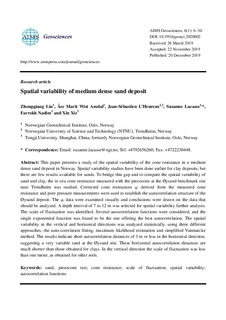Spatial variability of medium dense sand deposit
Liu, Zhongqiang; Amdal, Åse Marit Wist; L Heureux, Jean-Sebastien; Lacasse, Suzanne; Nadim, Farrokh; Xie, Xin
Peer reviewed, Journal article
Published version
Permanent lenke
http://hdl.handle.net/11250/2636757Utgivelsesdato
2019Metadata
Vis full innførselSamlinger
- NGI articles [1061]
Sammendrag
This paper presents a study of the spatial variability of the cone resistance in a medium dense sand deposit in Norway. Spatial variability studies have been done earlier for clay deposits, but there are few results available for sands. To bridge this gap and to compare the spatial variability of sand and clay, the in situ cone resistance measured with the piezocone at the Øysand benchmark site near Trondheim was studied. Corrected cone resistances qt derived from the measured cone resistance and pore pressure measurements were used to establish the autocorrelation structure of the Øysand deposit. The qt data were examined visually and conclusions were drawn on the data that should be analyzed. A depth interval of 7 to 12 m was selected for spatial variability further analysis. The scale of fluctuation was identified. Several autocorrelation functions were considered, and the single exponential function was found to be the one offering the best autocorrelation. The spatial variability in the vertical and horizontal directions was analyzed statistically, using three different approaches, the auto-correlation fitting, maximum likelihood estimation and simplified Vanmarcke method. The results indicate short autocorrelation distances of 3 m or less in the horizontal direction, suggesting a very variable sand at the Øysand site. These horizontal autocorrelation distances are much shorter than those obtained for clays. In the vertical direction the scale of fluctuation was less than one meter, as obtained for other soils.
